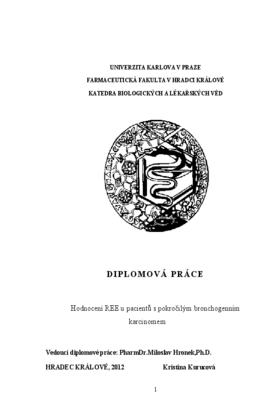Hodnocení REE u pacientů s pokročilým bronchogenním karcinomem.
Evaluation of REE at patients with advanced bronchogenic carcinoma.
diplomová práce (OBHÁJENO)

Zobrazit/
Trvalý odkaz
http://hdl.handle.net/20.500.11956/41221Identifikátory
SIS: 103347
Kolekce
- Kvalifikační práce [6562]
Autor
Vedoucí práce
Oponent práce
Hrnčiarik, Michal
Fakulta / součást
Farmaceutická fakulta v Hradci Králové
Obor
Farmacie
Katedra / ústav / klinika
Katedra biologických a lékařských věd
Datum obhajoby
7. 6. 2012
Nakladatel
Univerzita Karlova, Farmaceutická fakulta v Hradci KrálovéJazyk
Čeština
Známka
Výborně
9 Souhrn Pro pacienty s bronchogenním karcinomem jsou charakteristické jevy jako je nádorová kachexie a zvýšený klidový energetický výdej. Tento zvýšený klidový energetický výdej vede ke ztrátě hmotnosti. Tato studie byla zaměřena na pacienty s pokročilým bronchogenním nemalobuněčným karcinomem (stadium III a IV) podstupující chemoterapii. Klidový energetický výdej byl měřen ve třech časových intervalech pomocí indirektní kalorimetrie u 10 pacientů (7 mužů, 3 ženy) s NSCLC podstupující chemoterapii (průměrný věk 64,3 let ± 7,79 let) na oddělení Centrum pro výzkum a vývoj. Klidový energetický výdej byl měřen před chemoterapií, v průběhu a po skončení chemoterapie. Prokázali jsme zvýšený klidový energetický výdej u těchto pacientů jak před samotnou chemoterapií, tak také v průběhu chemoterapie. Během chemoterapie došlo ke snížení REE. Průměrná hodnota REE u prvního vyšetření (% z predikovaných z HB) byla 116,6 % ± 15,95 %, u druhého měření byla průměrná hodnota 113,9 % ± 14,73 % a u třetího vyšetření jsme zaznamenali tuto průměrnou hodnotu 106,5 % ± 12,66 %. Můžeme potvrdit, že klidový energetický výdej je u pacientů s NSCLC zvýšený, v průběhu chemoterapie se mírně snížil. Klíčová slova: nemalobuněčný karcinom plic, klidový energetický výdej, indirektní kalorimetrie, Harris-Benedictova rovnice
10 Abstract For patients with lung cancer are characterized phenomena such as cancer cachexia and increased resting energy expenditure. This increased resting energy expenditure leads to weight loss. This study was focused on patients with advanced non-small cell lung cancer (stage III and IV) undergoing chemotherapy. Resting energy expenditure was measured at three intervals by using indirect calorimetry in 10 patients (7 men, 3 women) with NSCLC undergoing chemotherapy (mean age 64,3 years ± 7,79 years) at a Department of Centre for Research and Development. Resting energy expenditure was measured before chemotherapy, during and after chemotherapy. We observed increased resting energy expenditure in these patients both before chemotherapy alone, as well as throughout chemotherapy. During chemotherapy there was decrease in REE. The average value of REE in the first test (% of predicted of HB) was 116,6 % ± 15,95 %, in the second measurement was mean value 113,9 % ± 14,73 % and for the third examination we noticed that the average value 106,5 % ± 12,66 %. We can confirm that resting energy expenditure in patients with NSCLC is increased during chemotherapy slowly decreased. Keywords: non-small cell lung cancer, resting energy expenditure, indirect calorimetry, Harris-Benedict equation
